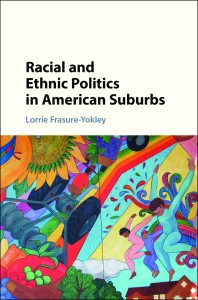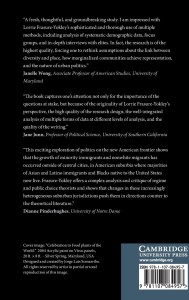BOOK AVAILABLE NOW!
Racial and Ethnic Politics in American Suburbs. New York, NY: Cambridge University Press.
2016 winner of two national book awards including, the Best Book about Race Relations in the United States by the Race, Ethnicity, and Politics (REP) Section and the Dennis Judd Best Book Award by the Urban and Local Politics Section of the American Political Science Association (APSA).
Click here for Cambridge University Press.
Also available on Amazon.
This book is about the unprecedented rise of immigrant and ethnic minorities in American suburbs, and specifically, the development and implementation of the policy responses of local governments to these recent mobility patterns. Today, most blacks, Latinos, and Asian Americans reside in the suburbs. Despite unprecedented demographic shifts, existing scholarship is slow to explain the dynamics of new population growth of immigrants and ethnic minorities into various types of suburbs and the implications for American politics. We know very little about how recent immigrant and ethnic minority suburbanization is reshaping American residential patterns, political life and the exercise of American democracy. Moreover, scholars continue to rely on models developed when these groups were primarily urban dwellers to understand the politics of redistribution in the U.S.
I use national survey data from the US Census and original data collected including in-depth interviews, focus groups, and participant observations in Maryland and Northern Virginia to explain four factors related to new patterns of immigrant and ethnic minority suburbanization. These factors include: why some racial/ethnic groups move to certain types of suburbs, how they interact with their neighbors, how they perceive their local government’s responsiveness to their needs and concerns, and finally, the policy responses of local governments to demographic change.
The study examines the institutional logic behind coalitions of local institutional actors to design redistributive policies addressing immigrant and ethnic minority newcomers in increasingly diverse suburban jurisdictions. I argue that both the political economy approaches of public choice theory (particularly economic sorting models); and urban regime theory literatures in the political science discipline fail to explain the mechanisms that drive some suburban governments to work with community-based organizations to provide goods and services to foreign-born and US-born minorities in the absence of either federal government or private sector funding that could allow for greater redistributive spending, or electoral pressures from voters acting as part of electoral coalitions. Institutional actors in some suburban jurisdictions are seemingly acting counter to their locality’s economic development interests and the interests of the upper income populations who are still their principal electoral constituents.
To address these concerns, I advance a framework called Suburban Institutional Interdependency or SII. This framework is used to explain how some suburban institutional actors (particularly electoral, bureaucratic and non-profit) form alliances between unlikely partners to advance policies and programs to provide goods and services to immigrants and ethnic minorities. I argue that local public and non-profit institutions build partnerships based on reciprocity, repeated interactions, and the exchange of selective incentives. Moreover, institutional interdependency in suburbia includes a division of labor and resources which facilitate the process of “getting things done” in the face of rapidly changing demographics, tightening local budgets and a lack of redistributive dollars from the federal government.
I examine the extent to which SII explains how local institutional actors respond to three policy issues: public education: the provision of support services for limited-English-proficient (LEP) children in suburban public schools; day labor: the establishment of several formal, institutionalized (local government-funded) day-laborer employment sites; and language access at public agencies: access to government services for adults with Limited English Proficiency (LEP). I use a combination of census data, as well as qualitative data from over 100 face-to-face, semi-structured in-depth interviews and participant observations among state and local elected/appointed officials, bureaucratic service and regulatory agency administrators, and community-based organization leaders in suburban Washington, DC.
Cover Image: “Celebration to Food Plants of the World” 2004 Acrylic pain on Viroc panels, 20 ft. x 8ft. – Silver Spring, Maryland, USA. Designed and created by Jorge Luis Somarriba. All rights reserved by the artist in partial or total reproduction of this image.

